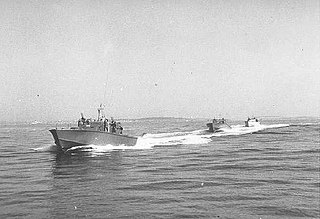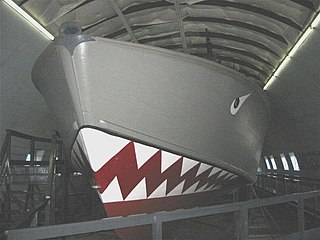 W
WA PT boat was a motor torpedo boat used by the United States Navy in World War II. It was small, fast, and inexpensive to build, valued for its maneuverability and speed but hampered at the beginning of the war by ineffective torpedoes, limited armament, and comparatively fragile construction that limited some of the variants to coastal waters. In the USN they were organized in Motor Torpedo Boat Squadrons (MTBRONs).
 W
WPT-20 was the first PT-20-class motor torpedo boat of the United States Navy that served during World War II.
 W
WPT-29 was a PT-20-class motor torpedo boat of the United States Navy American that served during World War II.
 W
WPT-30 was a PT-20-class motor torpedo boat of the United States Navy American that served during World War II.
Patrol torpedo boat PT-41 was a PT-20-class motor torpedo boat of the United States Navy, built by the Electric Launch Company of Bayonne, New Jersey. The boat was laid down as Motor Boat Submarine Chaser PTC-21, but was reclassified as PT-41 prior to its launch on 8 July 1941, and was completed on 23 July 1941. It was used to evacuate General Douglas MacArthur from Corregidor at the beginning of the war in the Pacific in World War II.
 W
WPT-42 was a PT-20-class motor torpedo boat of the United States Navy that served during World War II.
 W
WPT-59 was an S-Class Patrol Torpedo boat of the United States Navy, built by the Electric Launch Company of Bayonne, New Jersey. The boat was laid down as Motor Boat Submarine Chaser PTC-27, and was reclassified as BPT-11 when assigned to transfer to Britain under Lend-Lease. However, this was cancelled, and she was reclassified as PT-59 prior to launch on 8 October 1941, and was completed on 5 March 1942.
 W
WPT-105 was a PT boat of the United States Navy during World War II. The 80-foot (24 m) motor torpedo boat was built by the Elco Motor Yacht Company of Bayonne, New Jersey, in early 1942, and served until the end of the war.
 W
WPT-109 was an 80' Elco PT boat last commanded by Lieutenant John F. Kennedy, future United States president, in the Pacific theater during World War II. His actions in saving his surviving crew after the sinking of PT-109 made him a war hero. PT-109's ramming by a Japanese destroyer contributed to Kennedy's long-term back problems and required months of hospitalization at Chelsea Naval Hospital. Kennedy's postwar campaigns for elected office referred often to his service on PT-109.
 W
WPT-305, also known as USS Sudden Jerk, was a PT-200-class motor torpedo boat that served with Motor Torpedo Boat Squadron 22, assigned to the Mediterranean, based at Bastia, Corsica, and St. Tropez, France, where it participated in Allied invasions.
 W
WPT-337 was a PT-103-class motor torpedo boat that was sunk in action during the Pacific Theater of World War II in Hansa Bay, New Guinea, on March 7, 1944.
 W
WPT-346 was an 80 ft Electric Launch Company (Elco) motor torpedo boat which suffered the worst PT-boat friendly-fire casualties of World War II, with nine men killed and nine wounded by airstrike.
 W
WMotor torpedo boat PT-617, also known as Big Red Cock and Dragon Lady, "is the sole surviving 80' Elco type PT boat and represents the United States's most heavily used, highly favored, and combat-tested PT boat type in World War II." She is a museum ship at the PT Boat Museum in Fall River, Massachusetts. The 80-foot (24 m) Elco type boat was the predominant type and is the same type as the famous PT-109 commanded by John F. Kennedy; the 78-foot (24 m) "Higgins" boat is the other type.
 W
WMotor torpedo boat PT-658 is a PT-625-class Higgins 78-foot (24 m) PT boat, built for the United States Navy during World War II. PT-658 is a prime example of US Navy motor torpedo boat development during World War II. PT-658 was in the last group of four boats delivered from the 36-boat contract NObs-1680, October 1944 for PT-625 to PT-660. Delivered and accepted on July 31, 1945, she was fitted with all of the latest armaments and design modifications as a result of lessons learned from previous contracts and battlefield experience. In this way, PT-658 is a showcase of the final form that motor torpedo boats would take by the end of World War II. PT-658 was listed on the National Register of Historic Places on September 4, 2012. Of three PT boats listed on the National Register, she is one of 2 maintained in operating condition.
 W
WPT-796 is a 78-foot PT boat built by Higgins Industries of New Orleans in 1945. It was designated a National Historic Landmark in 1986 as one of a very few surviving World War II PT boats. A "Higgins" boat, she is part of the collection of the PT Boat Museum, which itself is part of the Battleship Cove museum in Fall River, Massachusetts.
 W
WOn 11 March 1942, during World War II, General Douglas MacArthur and members of his family and staff left the Philippine island of Corregidor and his forces, which were surrounded by the Japanese. They traveled in PT boats through stormy seas patrolled by Japanese warships and reached Mindanao two days later. From there, MacArthur and his party flew to Australia in a pair of Boeing B-17 Flying Fortresses, ultimately arriving in Melbourne by train on 21 March. In Australia, he made his famous speech in which he declared, "I came through and I shall return".
 W
WQ-111 Luzon was a motor torpedo boat of the United States Army during World War II as part of the Offshore Patrol based at Manila.